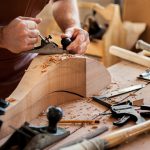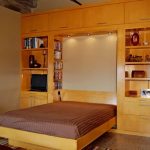We use many fine kinds of wood in the construction of our wall beds. Aside from the 5 types commonly used in our furniture construction elements, these woods add another element of artistry to our products.
Alder
Alder is white when freshly cut but quickly changes to light brown with a yellow or reddish hue with exposure to air. It has a simple, straight grain. Alder produces narrower boards with little color variations between heartwood and sapwood (the innermost and outermost parts of the tree). It takes stains exceptionally well and pricing is midrange between pines and more expensive hardwoods. It is also easier to dent and scratch than harder woods like maples. It is one of the best woods for painting because it does not soak up paint due to it not being very porous. Alder can be used to deliver a knotty, rustic or distressed appearance. Blemishes respond differently to color than the rest of its grain, which can give it a rustic aesthetic.
Ash
Ash grows in eastern and central North America throughout the east coast and parts of Canada. The light brown and creamy white colorations of ash look great with a simple clear finish and are strikingly beautiful. The grain is typically straight and a beige-to-light-brown color. It is a durable wood and has a long history in American furniture making. While it is durable, it can still be relatively lightweight and it absorbs stains well. In fact, the most popular use for ash lumber commercially is to impersonate oak. It can take some extreme color and still present its open grain “woody” look.
Cherry
Elegant, stylish and timeless, cherry wood has a signature look. It is good for the antique, vintage feel but can also feel aesthetically appealing in a very contemporary sense. Naturally beautifully colored, cherry wood comes in 2 different “colors” due to how the heartwood looks compared to the sapwood. The outermost exterior part of the tree is light, yellow and brownish tint. The heartwood from the center of the tree holds the darker, rich red-cherry tones. It is a hardwood that holds up well over time and is on the heavier scale of furniture woods. It is fine-grained and will take stains very well. You will often see cherry wood in armoires, dining room tables and other wood pieces that have detailed carvings because it is such a great wood to work in details with.
Pine
Pine has a creamy white look and is light in color. The shades vary from very white to a yellowish tint. This light color makes pine easy to stain and take on nearly any color. A clear coat works great to accent the natural color and protect it and show off the grain with knots that are darker than the rest of the wood. Due to the fast growth of pines, the pricing on pine is very reasonable and makes this an attractive option if pricing is a concern. Pine is a very stiff wood. This makes it durable and strong when used in furniture. It’s not quite as strong as oak, but it does still offer durability.
Maple
Usually, it is the heartwood that has the colors most sought after, but with maple, the sapwood is what is prized. Maple has a smooth grain pattern and is very durable. The color is a light creamy color, with mineral streaks adding some reddish-brown tints. Stains will bring out and highlight these streaks and the colors will deepen with age. The heartwood is a brownish-red and mellows over time. Grain patterns come in many variations that artisans can put to use, and the term “figured” is what is meant by these added grain characteristics. Figured wood is usually a result of some distress that occurred while the tree was growing and can give curly, wavy, flame and other patterns.
Red Oak
Oakwood is used in all kinds of furniture construction and other woods try to imitate its characteristics. Oak barrels are used in the aging of wines, brandy, Irish whiskey, Scotch whiskey, and Bourbon whiskeys. It is a very dense wood and fast-grown Red Oak has wider rings and is heavier than slow-grown Red Oak. The sapwood of Red Oak is white to very light brown, while the heartwood is reddish brown.
Oak grain is easy to recognize by the long curvy patterns of darker and lighter rings. Natural oak can take on hues from light beige to browns and reds. There are pores in both White and Red Oaks, and the pores found in the growth rings on red oak are very open and porous. Another unique characteristic to oaks are little dark brown streaks running with the grain, sometimes referred to as rays. Red Oak can look like a pencil was used to draw dotted lines across it. White oak has longer rays.
White Oak
White oak looks more beige-to-brown and red oak looks rosier by comparison. Both red and white oak stain well, but White Oak is more water resistant. This is due to the pores being sealed off by tyloses. White Oak can is usually the slightly more expensive of the two.
Pecan
A southern hardwood, Pecan is so popular as dining and office furniture that many times the veneer pattern mimics Pecan. The colors vary from pale brown to reddish brown with dark streaks. The grain is usually straight and well defined but can occasionally be wavy as well. It has a low natural luster and can take stains and clear coats to give it shine if desired. The outer sapwood is a paler yellowish brown. The price is moderate compared to the other woods used in furniture making.
Walnut
Walnut is a hard, tough wood and has been a popular wood for gunstocks and rifle butts. Black Walnut wood is dark, hard, dense and tight-grained. The color varies from dark chocolate in the heartwood to a creamy white in the sapwood. Natural walnut polishes to a smooth finish and develops a shiny patina over time. The wide range between chocolate and creamy colors in the boards can make applying a consistent stain color to it trickier. Also, Walnut trees grow with a significant number of branches which will give it knots in the grain.
Visit our Build Your Own Murphy Bed form to request a price for your new wall bed!





